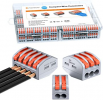Greg Elmassian
Guest
As I said, there are many variations, and if I was in the UK, I would consider the weatherproof ones. I would guess even in the UK, 3M is a big supplier.
what are choc-blocks? I'm keeping the goals of easy to install, no special tools, no soldering.....
Greg
what are choc-blocks? I'm keeping the goals of easy to install, no special tools, no soldering.....
Greg


